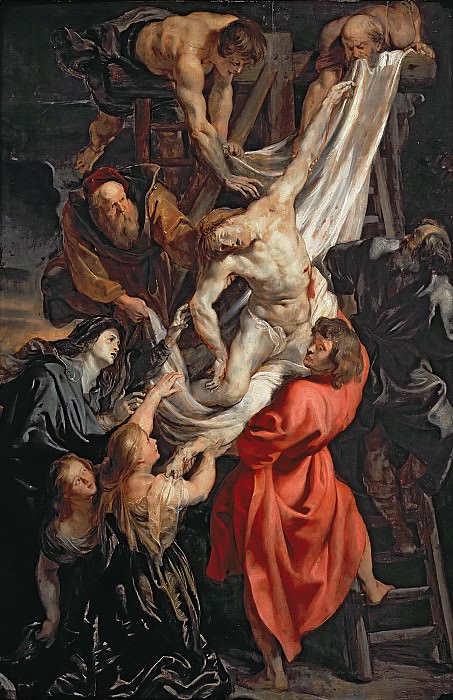Descent from the cross Peter Paul Rubens (1577-1640)
Peter Paul Rubens – Descent from the cross
Edit attribution
Download full size: 1293×2000 px (0,8 Mb)
Painter: Peter Paul Rubens
Peter Rubens painted his famous painting between 1610 and 1613. It was the fashion at the time to paint paintings on religious themes, and Rubens was no exception. Scholars have noted that the style and some elements of the painting show the influence of his teachers, Tintoretto and Caravaggio. At the center of the painting is the helpless body of Jesus, which is about to fall into the hands of the apostle John.
Description of Peter Rubens’ painting The Descent from the Cross
Peter Rubens painted his famous painting between 1610 and 1613. It was the fashion at the time to paint paintings on religious themes, and Rubens was no exception. Scholars have noted that the style and some elements of the painting show the influence of his teachers, Tintoretto and Caravaggio.
At the center of the painting is the helpless body of Jesus, which is about to fall into the hands of the apostle John. The artist deliberately painted the skin of the Son of God in lead color in order to compare the body, which has been hanging on the cross for weeks, with the marble statue. The image of Jesus is surrounded by the life-affirming robes of his disciples and all compassionate people.
Several elders have gathered around their spiritual mentor and are trying their last to help remove the body from the cross. Rubens has succeeded in emphasizing the frailty of the elder, desperately trying to hold on to the heavy body of Jesus.
The Mother of God stands out against the background of the commotion - she stands motionless, like a statue, her face is marble in color. The artist has skillfully portrayed all of Mary’s inner feelings. If you look closely at her face, you can read her thoughts: "I recently washed the feet of my beloved son, and now I have to watch as they take him dead from the cross.
Despite the "gravity" of the event, there is no overt "drama" and no attempt to play on feelings. There are no faked screams, tears, or theatrical gestures; the people simply remove the body of the Son of God from the cross. Despite the strong influence of his teachers, Rubens rejected the common grayish colors and painted his picture in light gray and amber. As a result, the painting is very realistic and lively.
Thus, this painting can safely be considered Rubens’ best work on a religious theme, and it earned him fame as a "defender of Christian values.
Кому понравилось
Пожалуйста, подождите
На эту операцию может потребоваться несколько секунд.
Информация появится в новом окне,
если открытие новых окон не запрещено в настройках вашего браузера.
You need to login
Для работы с коллекциями – пожалуйста, войдите в аккаунт (open in new window).





![Peter Paul Rubens - Drunk strong [School]](http://cdn.gallerix.asia/j/_EX/754398988/859649658.webp)














You cannot comment Why?
The deceased figure dominates the foreground; its torso is exposed, revealing wounds that suggest a violent demise. The pallor of the skin contrasts sharply with the darker tones surrounding it, drawing immediate attention to the vulnerability and suffering represented. A man in vibrant red robes stands prominently at the lower right, his posture suggesting both urgency and grief as he participates in the descent.
The lighting is dramatic, employing strong chiaroscuro effects that heighten the emotional impact. Areas of intense light illuminate key figures and details – the wounds on the body, the faces etched with sorrow – while other sections remain shrouded in shadow, contributing to a sense of somber atmosphere. The use of light also serves to sculpt the forms, emphasizing their physicality and the strain they endure.
The artist’s choice of color is deliberate; the red of the robes provides a focal point amidst the predominantly muted palette of browns, grays, and blacks. This splash of color might symbolize sacrifice or perhaps a glimmer of hope within the overwhelming darkness. The figures are rendered with considerable realism, their anatomy convincingly portrayed, which lends weight to the narrative’s emotional core.
Subtly, there is an interplay between strength and fragility. While some individuals display physical power in their efforts to lower the body, the overall impression is one of helplessness against a larger, unseen force. The composition evokes themes of loss, compassion, and the burden of suffering – a poignant depiction of grief and sacrifice.